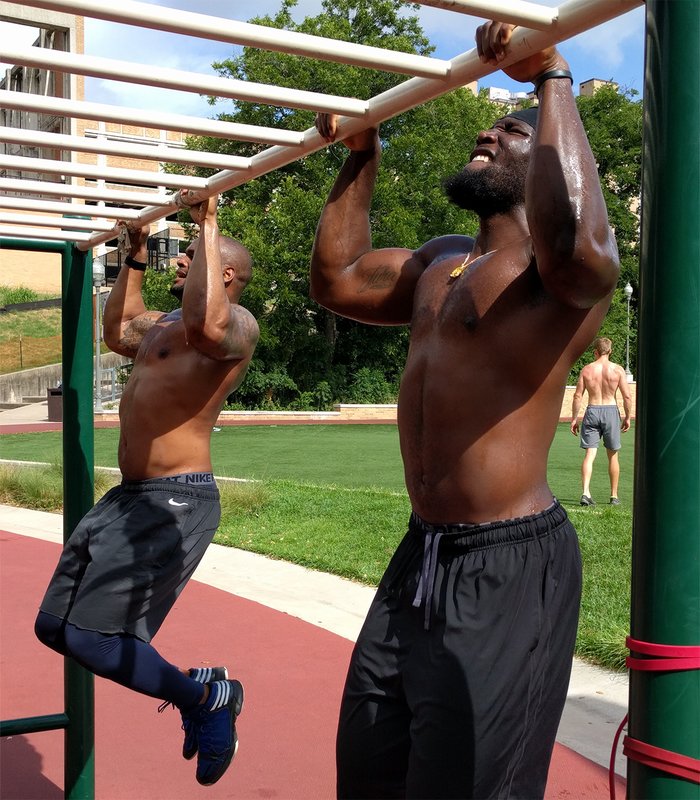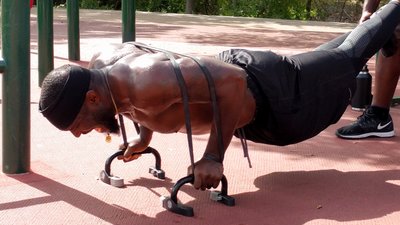A small crowd gathered at an athletic field in Austin, Texas, to watch four-time Pro Bowler Brian Orakpo and fellow NFL pros work out.
"These aren't just lifters," said Tim Crowder, former NFL-player turned NFL-trainer and founder of Austin, Texas-based company Nuclear Athletes. "These are football players. They have to do it all."
Even though today's workout is focused on upper-body strength, the day doesn't start there. Before Crowder announces that it's time to start resistance training, these ballers have already done foam rolling, an active warm-up, agility work, balance training, and football drills.
In fact, this crew has put in a good hour's worth of work before they ever start their strength training.
An Unorthodox Approach to Training for Football
Unlike many workouts, this one doesn't start out in a gym filled with barbells and benches. Instead, Crowder leads Orakpo and his fellow athletes, Jerrell Freeman of the Chicago Bears and free agent IK Enemkpali, about 15-feet south of the gym door to an outdoor jungle gym adjacent to the playing field. Aside from the jungle gym itself, the only equipment in sight are heavy-duty resistance bands and enough push-up bars to go around.
"Today's a lighter-resistance day, but with a ton of reps, making it a big hypertrophy-and-muscular-endurance day," Crowder explained. "Many of my colleagues get caught up in moving iron. I get caught up in moving resistance, whether it's in the form of bands, water, iron, hills, or vehicles."
Crowder says he believes in mixing it up instead of relying on weight training alone.
"My program evolves each year and lately I've been shifting more and more to bands for certain exercises," he says. Why? "Because bands work."

Specifically, he says, they work for athletes like Orakpo who need programs that prioritize flexibility, agility, core strength, and balance every bit as much unadulterated physical strength.
Orakpo admits he's a fan of more traditional exercises like the dumbbell bench press, incline press, and military press, but he acknowledges that Crowder's use of bands has helped.
"Pumping iron is good, but as you get older, you need to back off a bit on arm strength and focus more on core strength and flexibility," Orakpo says. "I get paid for dealing with lots of 300-pound guys, so I have to be as big and strong as I can be. But if I'm not as strong as some of the younger players I face, I'd better finds ways to be more powerful, faster, more agile—and smarter—than they are."
Orakpo says Crowder's somewhat unorthodox approach to strength training is what keeps him at the top of his game—even as he heads into his ninth professional season.
Doing the Band Workout Right
The trick to Crowder's training program is his use of resistance bands—but not the flaccid, overly-stretched bands you find in most gyms and physical-therapy offices. These bands are heavy duty, designed to deliver the equivalent of anywhere from 30-150 pounds of resistance, depending on the band.
"The taller a person is, the farther the bands stretch during an exercise to further increase resistance," Crowder says. "The NFL guys I'm training are all tall guys, so they're experiencing greater resistance at the peak of an exercise than someone shorter would."
The resistance the athletes push against includes far more than the rating of the band itself. When they do banded push-ups, for example, they're pressing against the band's resistance—plus their own body weight. For these guys, these little bands can bring a lot of pain!
The Meat of the Program
Crowder never delivers two identical workout routines. But the band programs he designs for Orakpo and other players tend to follow a similar trajectory: Tax the major upper-body muscle groups with compound exercises such as push-ups and pull-ups, then burn up the smaller muscle groups with fast supersets and high repetitions.
Here are some of Crowder's favorite upper-body exercises—with and without bands:
Banded Partner Push-ups: 4 sets of 25, 20, 15, 10 repetitions
Wrap a band over your upper back, holding the ends down with each hand to keep the band secure. As you lower yourself into push-up position, tighten your core and keep your lower back engaged and aligned with your shoulders and feet. Have your partner pick up your legs from the ground, suspending you in the air so you must work harder to keep your core tight.
For the first set, place your hands in a neutral position and perform 25 push-ups. For the second set, place your hands wide and perform 20 more push-ups. For the third set, bring your hands close together and do another 15 push-ups. For the final set, put the band aside and do your final set of 8-10 reps using your body weight alone. Pause at the top and bottom of each rep.
Varied Grip Pull-ups: 3 sets to failure
No surprises—or bands—on this next exercise. For the first set, use a traditional pull-up grip, with your palms facing away from you and your arms positioned slightly wider than shoulder-distance apart.
For the second set, use a neutral grip so your palms face each other.
For the third set, use a reverse grip, rotating your palms to face you. In each set, perform as many repetitions as possible while maintaining good form.
Banded Single-Arm Chest Fly and Reverse Fly Superset: 3 sets of 10 repetitions
Attach a band to a sturdy vertical post and position it at chest height. Stand with your left shoulder toward the post and grab the loose end of the band with your left hand. Position yourself far enough away from the post so that when you stretch your left arm toward the post, the band remains taut.
With your core tight and knees slightly bent, pull your left arm from its outstretched position to the center of your chest, keeping your arm level as your quickly perform the movement. Keep your working arm at chest height throughout. Perform 10 fast reps.
Immediately superset the action by turning your body 180 degrees, keeping the band in your left hand so the band now crosses in front of your body. The band should now be taut when your left arm is reaching straight out in front of your chest. Engage your core and upper back, pulling the band tight as you extend your arm out wide to the left of your body. Return to center and perform 10 more fast but controlled repetitions.
Repeat the superset using your right arm, performing a total of three sets of 10 reps.
Banded Shrugs: 4 sets of 30, 30, 30, 50 repetitions
Using a heavy band, hold the band down in front of you and step onto the center of it with both feet. Holding an end of the band in each hand, stand tall and engage your core. Now draw both shoulders up toward your ears for 10 reps. On the tenth rep, hold your shoulders high in the shrugged position for a count of 10 before continuing. Complete three sets like this, each set of 30 consisting of three smaller sets of 10 reps with a 10-second hold on the tenth rep.
For the fourth and final set, complete 50 repetitions as fast as you can while maintaining good form. Take breaks as needed until you reach 50.
Partner-Resisted Negative Lateral Raises: 2 sets of 10 repetitions
Stand facing your partner. Raise your arms out laterally so they're extended at shoulder height. Your partner places one hand on top of each of your forearms, near your wrists, then presses down forcefully, trying to lower your arms to your sides.
Your goal is to resist the action and try to prevent your partner from lowering your arms. Complete 10 fast but controlled repetitions before switching roles with your partner. Each partner should perform 2 sets of 10 reps.
Partner-Resisted Negative Front Raises: 2 sets of 10 repetitions
Stand facing your partner and extend your arms in front of you at shoulder height. Your partner places one hand on top of each of your hands or wrists. As your partner presses down forcefully and tries to lower your arms to your hips, resist the action and try to prevent your arms from being lowered.
Complete 10 fast but controlled repetitions before switching roles. Perform 2 sets of 10 reps each.
Banded Triceps and Biceps Superset: 3 sets of 10 repetitions
Attach a band to a sturdy vertical post and position it above your head. Grab the free end of the band with your right hand and, facing the post, step away until the band is taut when your elbow is bent and your hand is at shoulder height. Step your left foot behind you slightly, engage your core, and lean your torso forward. Keeping your upper arm steady and close to your side, press your right hand straight down, extending your elbow to engage your triceps. Perform 10 fast but controlled repetitions.
Without stopping to switch hands, immediately superset the action by repositioning the band at or below knee-height on the vertical post. Step away from the post, holding the free end of the band in your right hand, your upper arm fixed to your side, your elbow extended. When the band is taut, stagger your feet, engage your core, and perform a curl, bending your elbow to draw it toward your shoulder. Reverse the movement to accentuate the negative portion and perform 10 more fast but controlled repetitions.
Once you have finished these right-hand curls, immediately switch arms and do ten quick curls with your left hand, followed by 10 quick triceps press-downs with your left hand. In total, you should complete three sets of 10 reps each with both arms.

